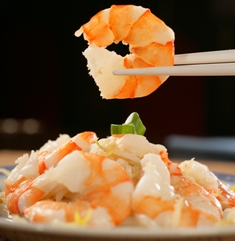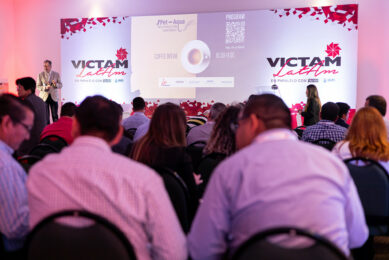Victam Asia provides great aquafeed update

The conference Aquafeed Horizons Asia, organised at Victam Asia in Bangkok, March 6 provided a great update on the current issues in aqua feed ingredients and processing. The conference was organised by www.aquafeed.com and attracted around 90 attendees. Emmy Koeleman visited the conference and reports on the topics presented.
Dr Juadee Pogmanereet from the Thai Department of Fisheries Aquaculture opened the conference with her speech on aquafeed and aquaculture production and policies in Thailand. She said that aquaculture Thailand has considerably developed, not only to increase productivity but also quality and safety products for the consumer throughout the production line. It is well known that the shrimp aquaculture industry plays a vital role in the Thai economy as it generates significant income, employment and foreign exchange earnings. Thailand has been able to export cultivated marine shrimp since 1991.
The total production of marine shrimp in 2005 and 2006 was about 380,000 tonnes and 520,000 tonnes, respectively. Nevertheless, shrimp farming development has been drawn into controversies associated with environmental concerns and food safety issues. The total production in 2007 was about 530,000 tonnes and expected not to exceed 500,000 tonnes in 2008. However, cultured shrimp species today has changed from black tiger shrimp to the white shrimp (Penaeus vanamei) in the quantity ration about 2-5% for black tiger shrimp and 95-98% for white shrimp, Pogmanereet outlined. This is due to the uncertainty of qualified brood stock of black tiger shrimp and the disease problem of viruses namely WSSV, TSV and IHHNV as well as high stocking density of intensive cultivation system.
Environmental concern
According to Pogmanereet, the important role of aquaculture in Thailand has to be developed to a more sustainable system, friendly to the environment, concerning the safety to aquatic animals and safety products. The major shrimp importing countries have gradually imposed stringent policies and regulatory measures to ensure that the shrimp farming practice is environmental friendly and the product complies with food standards. Consequently, efforts have been made to improve and regulate all shrimp farming practice under a standard system of Good Aquaculture Practice (GAP) or Code of Conduct (CoC) programmes and the minimum requirement of food safety for the local consumption. Innovative feed formulation concepts Dr Peter Coutteau from Inve Aquaculture Nutrition in Belgium talked about innovative concepts in aquafeed formulation to optimise performance and health. According to Coutteau, the aquafeed industry is a dynamic one, but is plagued with some problems. For example, diseases, global scarcity of certain feed ingredients, consumer sensitivity for quality and food safety and sustainable use of fish feed ingredients such as fish meal and oil. He comments that aquafeed diets are now more focused on getting more nutrients out of existing ingredients. This has boosted the use of the enzyme phytase for example. Also more digestibility enhancers are used in feed formulations these days. Further work at Inve includes the understanding of different mechanisms for different species, optimising the application of ingredients in feed mills and fine tuning the application of ingredients for maximum formulation flexibility.
Use of feeding attractants
Dr Andrew Moore from the Centre for Environment, Fisheries and Aquaculture Science in the UK gave a presentation about the development of novel feeding attractants for sustainable aquaculture. He explained that attractants (such as the product Aquatice) can be better used directly in the water instead of incorporating them in the feed pellets. In addition, Moore emphasised that the use of pharmaceuticals may negatively impact the sense of smell of the fishes and shrimps. This leads to decreased detection of the attractants used. Trials with the product Aquatice also showed higher growth and survival in tilapia, Moore pointed out. Also the size, length and weight of the animals were better than the control group.
Palatability improvements in shrimp
Dr Vincent Fournier from Aquativ in France updated the participants on palatability improvements in shrimp feed. Fournier explained that some recent trials that have been conducted in which several palatability enhancers were added to low fish meal shrimp diets. These diets were then compared with diets that contained high levels of fish meal. Results showed no significant differences between the low and high fish meal diets. According to Fournier, it is therefore possible to replace scarce raw materials such as fish meal with more available plant based materials when using attractants.
Use of krill as feed ingredient
Dimitri Sclabos from Tharos in Chile spoke about the South Antartic krill industry and discussed the issue of how far krill derivatives can become a real feed ingredient substitute. Krill are tiny shrimp, found in the Antartic waters and mainly fished by countries such as Japan, Poland, Norway, Russia and Korea. In the 1980s, around 400,000 tonnes of krill was catched, but this has decreased to 260,000 tonnes in 2008 (forecast). Sclabos explained that this reduction is due to stricter legislation (reduced amount of allowable catch per year). The use of krill as an aquafeed ingredient is interesting because it provides a high oil content (phospholipids and omega 3), and can thus be an alternative for the pricy fish oil. In addition, it has great nutritional aspects, a high protein content (63%) and is palatable for fish.
Different extrusion processes
Galen Rokey from Wenger Manufacturing in the US gave a speech about the ingredient trends and the effects on the extrusion process. He explained that extrusion makes it possible to make very small particles, to make sinking or floating feet and it enables to use a higher level of fat (internal fat and fat coating). When using atmospheric coating, a maximum of 20% of fat van be incorporated in the pellet. When a fat content of more than 20% is desired, the vacuum coating techniques should be used.
The use of krill as an aquafeed ingredient is interesting because it provides a high oil content (phospholipids and omega 3), and can thus be an alternative for the pricy fish oil. However, it also provides a great food source for marine animal species (such as whales). Sustainable fishing is therefore of utmost importance.
Technical advancements for shrimp
Joe Kearns, also from Wenger in the US gave a presentation about the technical advancements in extruded shrimp feeds. Kearns explained that the following factors need to be taken into consideration: the feed must target the nutritional requirements of the animals (shrimps in this case), the feed must be of high quality, it has to follow environmental compliance and lastly, the feed has to have favourable economic considerations. Kearns explained that fish feeding started with hand feeding of mixed feeds, then it moved to cold forming/moist diets, then the feed was produced with the pellet cooker. Nowadays, most aqua feed is produced by extrusion. Extrusion enables the production of floating and sinking pellets, smaller pellet sizes (for shrimps for example) and will eradicate anti nutritional factors, viruses and other pathogens. Kearns said that Wenger is currently looking at producing more user friendly machines and techniques to be able to produce multiple products at the same time. Wenger is also working on increasing the capacity of the extruders.
Alternatives for fish meal and oil
Ernest Papadoyianis from Neptune Industries in the US discussed sustainable production of a high quality fishmeal substitute from insects. He explained that the aqua feed industry is dangerously dependent upon fishmeal as a key protein constituent in fish and shrimp diets. He also emphasised that a staggering 25% of all world fish production goes into fishmeal and fish oil. Alternative products for fish oil and meal are plantbased proteins such as such as soybean, wheat, and corn. Plant-based by-products such as the dried distilled grains (DDGS) from ethanol production, and other similar products from other bio-diesel are now becoming more available, however are generally, lower in protein than the original grains themselves.
Seaweeds and algae have also been used on a limited basis in fish and shrimp diets, and further research is underway to evaluate the quality and quantity of different sources. Bacteria-based proteins are currently being researched and while the initial data on the quality of the proteins appears favourable, the economics are questionable. Animal proteins typically used in fish diets include poultry meal, feather meal, blood meal, and with less frequency, beef heart, collagen protein, etc. Animal proteins have superior amino acid profiles to plant proteins, as well as higher overall protein content.
While superior to plant protein, these animal proteins are not foods naturally eaten by fish, and therefore have certain nutritional shortcomings relative to fishmeal, Papadoyianis explained. One class of alternative protein sources has drawn particular attention – Insects. Neptune Industries, Inc has filed a process patent on the production protocol for a product called Ento-Protein™. This product is a high quality dry protein meal created from commercially raised and processed insects. Through a cooperative research effort with Mississippi State University (MSU), Neptune is in the beginning stages of assessing its commercial feasibility. Maybe in the future, this will provide a necessary solution to sustainable, all-natural, and organic based fish and animal production, Papadoyianis concluded.
Other speakers at the conference included Will Henry from Extru-Tech in the US, Colin Mair from Cormal Technologies in the UK and Sal Cherch from Neptune Industries in the US.
Source:











